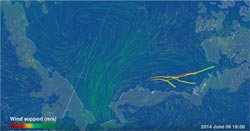Blowing in the wind: A polygynous shorebird decides where to breed based on the prevailing wind conditions

Video: Electronic supplementary material: Krietsch J, Valcu M, Kempenaers B. 2020 Wind conditions influence breeding season movements in a nomadic polygynous shorebird. Proc. R. Soc. B XXX: 20192789. http://dx.doi.org/10.1098/rspb.2019.2789
Pectoral sandpipers (Calidris melanotos) migrate long distances, also during the breeding season. After a journey from the wintering grounds in the Southern Hemisphere, their breeding area extents over thousands of kilometers along the arctic shores.
Pectoral sandpipers are polygynous and males intensively compete for fertile females. However, even after successful reproduction males do not stay with the females and their offspring. Most males visit multiple sites across a considerable part of their entire breeding range in search of mating opportunities.
A former study by Bart Kempenaers and Mihai Valcu of the Max Planck Institute for Ornithology in Seewiesen showed that males visited up to 24 potential breeding sites during the four to six weeks breeding season, covering distances of up to 13000 kilometers.
Now the researchers wanted to find out whether the direction of the initial movement away from the study site, which ultimately decides whether males breed in the Russian or North American Arctic, could be based on the prevailing wind conditions.
Utqiaġvik (formerly Barrow, Alaska), the northernmost city in the United States, is a breeding site right in the centre of the pectoral sandpipers’ summer range. Based there, the researchers tracked the flights of a total of 80 males over two years with the help of small (5 g) satellite transmitters and calculated the wind support with data from a global re-analysis model.
Males flew either west into the Russian Arctic, or east into the North American Arctic, but the proportion going west differed substantially between the years.
Males visited Russian breeding sites mainly under supportive wind conditions
Males that went west benefited from strong tailwinds, whereas males that went east more often faced headwinds. “Males that decided to fly west into the Russian Arctic will later need more resources to cover a much longer migration distance”, explains Johannes Krietsch, first author of the study.
“Males flying east into the Canadian Arctic were already moving closer to the Hudson Bay, a common stop-over area also used by males that bred in the Russian Arctic, on the way to their wintering grounds”.
Some of the males did not take the shortest route to their destination but made loop-like flights over the arctic ocean and thus took large detours of thousands of kilometers. The data show that these loop flights could be explained by – possibly naïve – birds initially flying north with strong tailwinds and later changing direction to reach land.
Males fly in groups and an intriguing alternative hypothesis for these flights is related to group dynamics. If some males want to go east, while others are “pulling” the group to go west, they may initially fly north, until the group splits and they turn to their favourite direction.
In contrast to the migration routes to and from the wintering grounds, the nomadic movements within the breeding area depend on the actual environmental conditions and are therefore unpredictable regarding time and destination. “The breeding opportunities are indeed unpredictable for male pectoral sandpipers“, says Bart Kempenaers, who was leading the study.
“It is energetically costly to fight for a territory and for access to fertile females, with the additional challenges of little sleep under continuous daylight and time pressure given the short arctic breeding season”. In fact, the data show that males did not wait for optimal wind conditions for their departure. Instead, the wind influenced both the direction in which the males left and how far they flew and therefore ultimately, in which region they potentially reproduce.
Johannes Krietsch
Doctoral Student Department of Behavioural Ecology and Evolutionary Genetics
Max Planck Institute for Ornithology, Seewiesen
Phone: ++49 (0)8157 932-412
E-mail: jkrietsch@orn.mpg.de
Prof. Dr. Bart Kempenaers
Director Department of Behavioural Ecology and Evolutionary Genetics
Max Planck Institute for Ornithology, Seewiesen
Email: b.kempenaers@orn.mpg.de
Krietsch J, Valcu M, Kempenaers B. 2020 Wind conditions influence breeding season movements in a nomadic polygynous shorebird. Proc. R. Soc. B 20192789.
http://dx.doi.org/10.1098/rspb.2019.2789
https://www.youtube.com/watch?v=A-Q5J1wRBUA (Flight tracks of male pectoral sandpipers with wind support indicated)
https://static-content.springer.com/esm/art%3A10.1038%2Fnature20813/MediaObjects… (Flight tracks of male pectoral sandpipers over the entire breeding season)
Media Contact
All latest news from the category: Life Sciences and Chemistry
Articles and reports from the Life Sciences and chemistry area deal with applied and basic research into modern biology, chemistry and human medicine.
Valuable information can be found on a range of life sciences fields including bacteriology, biochemistry, bionics, bioinformatics, biophysics, biotechnology, genetics, geobotany, human biology, marine biology, microbiology, molecular biology, cellular biology, zoology, bioinorganic chemistry, microchemistry and environmental chemistry.
Newest articles

First-of-its-kind study uses remote sensing to monitor plastic debris in rivers and lakes
Remote sensing creates a cost-effective solution to monitoring plastic pollution. A first-of-its-kind study from researchers at the University of Minnesota Twin Cities shows how remote sensing can help monitor and…

Laser-based artificial neuron mimics nerve cell functions at lightning speed
With a processing speed a billion times faster than nature, chip-based laser neuron could help advance AI tasks such as pattern recognition and sequence prediction. Researchers have developed a laser-based…

Optimising the processing of plastic waste
Just one look in the yellow bin reveals a colourful jumble of different types of plastic. However, the purer and more uniform plastic waste is, the easier it is to…



